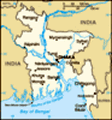Advertisement
Published: December 24th 2007
Blogger Dougo Having collected Bec’s brother Owen from the airport last night, our posse had grown to five. A word of warning to anyone reading this blog: DO NOT FLY TO BANGLADESH WITH GMG AIRLINES if you want to arrive on time. We had heard stories from existing staff that GMG never depart and arrive on time, but until now we didn’t really appreciate them. Owen was due to arrive from Bangkok at 6pm. He walked out of Zia International Airport, Dhaka, at 2am. Delay after delay after delay. Totally dead to the world we all got home at 2:30am.
Today was Eid ul-Fitr, the day of sacrifice. For those of you who haven’t read the last blog entry I will once again (via copy and paste) tell you a little about what this day means to Muslims all over the world:
“So what’s the point of all this you ask? Well the Muslim faith has two main festivals each year based on the Quran. The first is Eid ul-Fitr which takes place after the fast for Ramadan. The other is Eid ul-Adha, otherwise known as the Festival of Sacrifice. It is a commemoration of Abraham’s
willingness to sacrifice his son, Ishmael, under the order of Allah. During Eid ul-Adha, Muslims who can afford to do so, sacrifice domestic animals (such as cows, goats and sometimes camels) as a symbol of Abraham’s sacrifice. According to the Quran, at least half of the meat must be given to the poor so that all Muslims do not go without sacrificial food during this time. The other half is prepared for a huge family feast or kept for personal consumption for the coming week. In a country of 150,000,000, 90% of whom are practicing Muslims, millions of which are living in poverty, you can see how this is a huge time for the Muslim people of Bangladesh. Thus, the huge number of livestock for sale downtown.” - Doug Taylor, 18/12/07, www.mytb.org/Doug-and-Bec
All week we have seen people, usually in groups of three or four, pulling mostly cows and goats through the streets around our home. They were tied up all along the footpaths with plenty of hay and water to keep them healthy and in tip-top condition for sacrifice. In an obscene display of wealth, some houses have 8 to 10 of these beasts secured under tarpaulins on the road in front of their house. The size of some of the bulls were incredible, with horns up to 45 cm long.
At around 8am, I awoke to the sound of drums and loud praying on the streets outside our house. At around 11am, I awoke to a clunking sound of knife on wood (or bone). Jim and Owen were more brave and ventured out for a morning walk. It is Jim’s pictures that grace this blog with the confronting reality of this cultural event. At around 7am, most of the livestock were slaughtered where they stood, on the side of the road or on the driveways of apartment buildings.
When Owen and I went for a bike ride late this afternoon, men were hosing down the road or powdering the puddles with lime to stop the blood from coagulating. We only saw one butcher at work and it was exactly what you would see over the counter at a butcher shop back home - large parts of a cow being carved into sections. Only difference here was, it was being done on a tarpaulin by a bare foot guy with no gloves.
As we rode through the streets we went through throngs of poor people waiting patiently outside the houses of those wealthy enough to afford a sacrifice. Unlike some nationalities who have zero concept of the idea of queueing, the poor here were all waiting patiently for their portion of beef. They would make their way from house to house, carrying their food in a dirty jute (hessian) bag. If any livestock had not been sacrificed, the poor would wait in the general vicinity until the ritual was conducted.
Leading up to today I was having mixed feelings about the idea of a mass sacrifice of all these animals. Then I came to the obvious realisation that it is what happens every day in almost every culture around the world. The only difference is that other forms of butchery lack the ceremony and the donation to the poor - really makes you open your eyes.
I can very easily see why people are vegetarians.
Advertisement
Tot: 0.137s; Tpl: 0.011s; cc: 10; qc: 64; dbt: 0.07s; 1; m:domysql w:travelblog (10.17.0.13); sld: 1;
; mem: 1.2mb


Lonerunner
non-member comment
Eid ul Azha
I was in Bangladesh during this festival also. I travelled to srimangal and to Barisal also. everywhere there were cattle market and i saw so many cows, numbers i never seen before ! That's a very good account that you made. LR